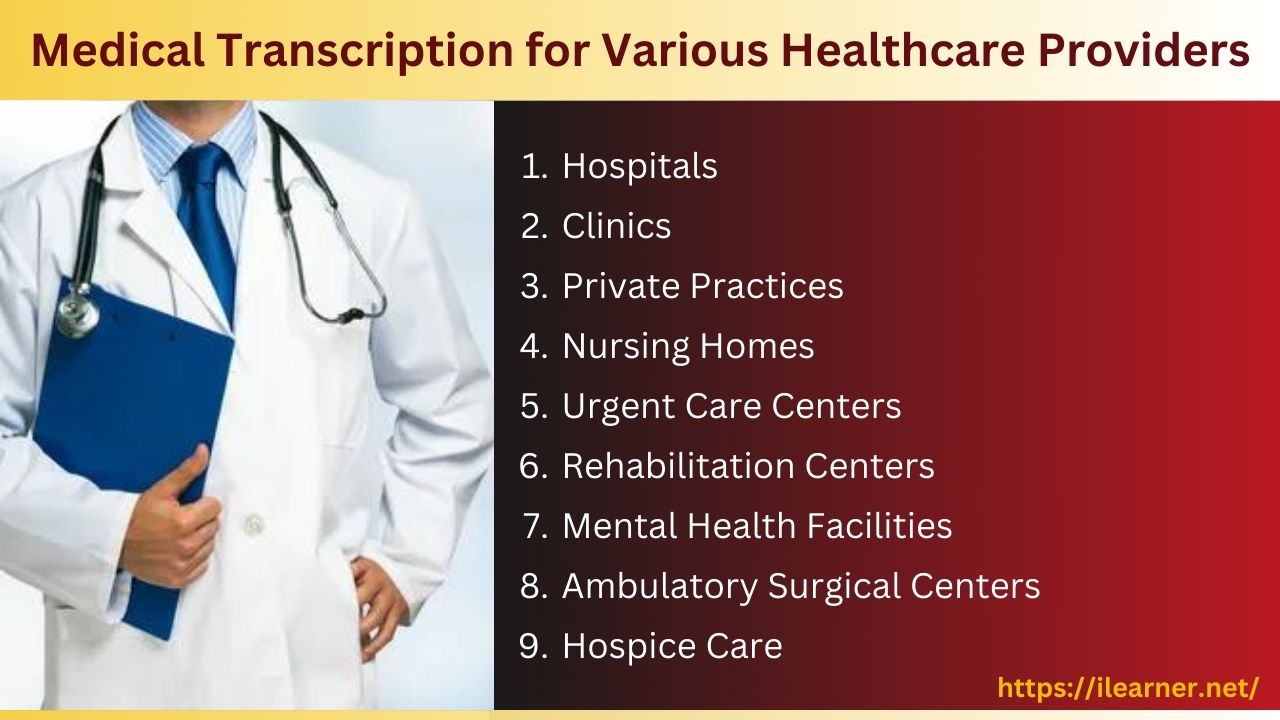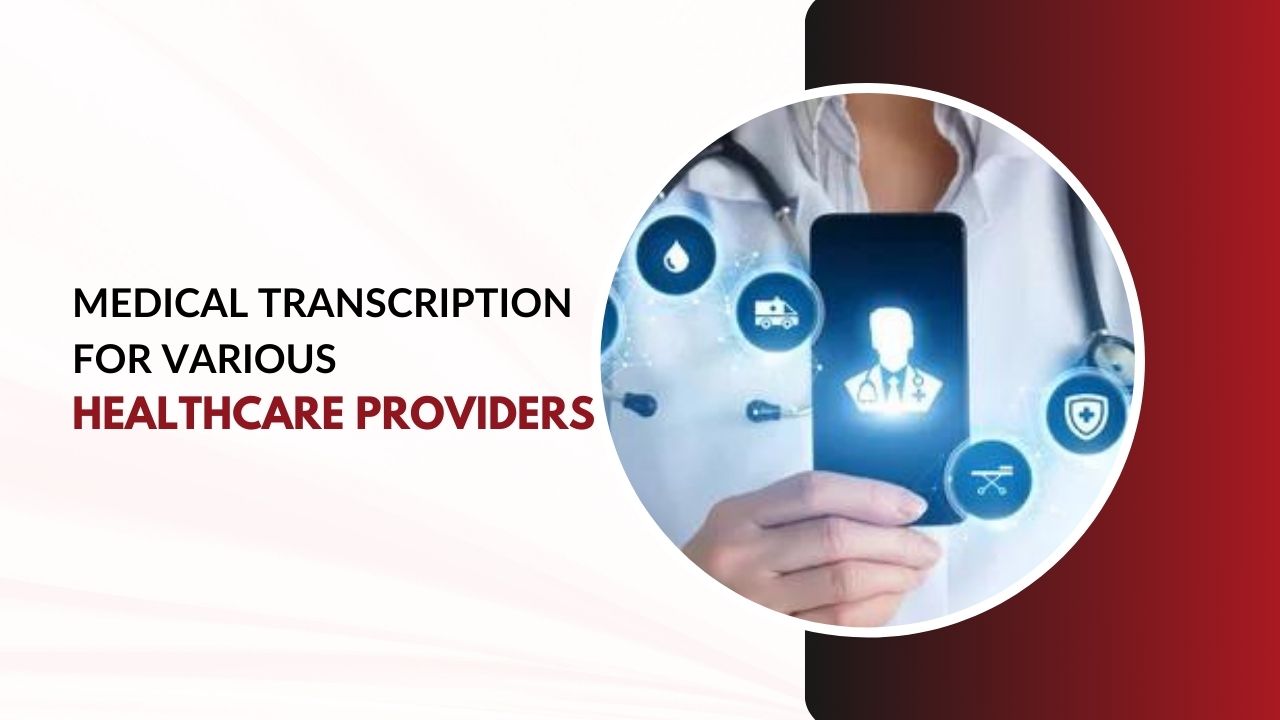Medical transcription is a vital component in healthcare that helps keep important patient records organized and accurate. It’s used by different types of healthcare providers, including hospitals, clinics, and private practices. Let’s explore how medical transcription benefits these healthcare settings.
Medical Transcription for Various Healthcare Providers: A Vital Tool for Record Keeping

1. Hospitals: The Busy Centers of Care
Hospitals are bustling places where a wide range of medical services are offered. In these settings, medical transcription is essential for documenting patient histories, diagnoses, treatment plans, and surgical procedures. Accurate and timely transcriptions are crucial because they ensure that healthcare providers can access vital patient information quickly.
2. Clinics: The Neighborhood Care Hubs
Clinics, often found in local communities, provide primary care services and specialized medical care. Medical transcription in clinics helps create records of patient visits, lab test results, and treatment plans. These records are vital for tracking patient health over time, ensuring that healthcare providers have a clear history of each patient’s medical journey.
3. Private Practices: Personalized Care
Private practices, run by individual doctors or small groups, offer a more personalized approach to healthcare. In these settings, medical transcription is used to maintain detailed records of patient consultations, diagnoses, and treatment recommendations. These accurate records enable private practitioners to tailor care plans to their patients’ specific needs and preferences.
4. Nursing Homes: Providing Long-Term Care
Nursing homes are facilities where elderly and chronically ill patients receive long-term care. Medical transcription is essential for documenting medication schedules, treatment plans, and medical histories. These records ensure that nursing home staff can provide consistent and quality care to residents, many of whom have complex medical needs.
5. Urgent Care Centers: Swift Medical Attention
Urgent care centers provide immediate medical attention for non-life-threatening illnesses and injuries. Transcriptionists help document patient visits, diagnostic tests, and treatment recommendations. The fast-paced nature of urgent care centers relies on accurate transcriptions to ensure that patients receive timely care and follow-up instructions.
6. Rehabilitation Centers: Restoring Functionality
Rehabilitation centers assist patients in regaining physical, cognitive, or emotional functionality after illness or injury. Medical transcription helps document therapy sessions, progress assessments, and personalized rehabilitation plans. These records are crucial for monitoring patients’ improvements and making necessary adjustments to their rehabilitation programs.
7. Mental Health Facilities: Nurturing Psychological Well-being
Mental health facilities focus on the psychological well-being of patients, addressing conditions like depression, anxiety, and schizophrenia. Transcriptionists create records of therapy sessions, psychiatric assessments, and treatment plans. These documents aid in monitoring patients’ mental health progress and ensuring they receive the appropriate care.
8. Ambulatory Surgical Centers: Efficient Surgical Care
Ambulatory surgical centers offer outpatient surgical procedures that don’t require overnight stays. Medical transcription is essential for documenting pre-operative assessments, surgical procedures, and post-operative care instructions. Accurate records are vital for patient safety and follow-up care.
9. Hospice Care: Compassionate End-of-Life Care
Hospice care provides compassionate care for individuals at the end of their lives. Transcriptionists help in recording patient histories, pain management plans, and caregiver instructions. These records are essential for ensuring that patients receive comfort and dignity in their final days.
Facts about Medical Transcription
1. Accuracy Matters: Medical transcriptionists must be highly accurate because errors in transcriptions can have serious consequences for patient care and legal matters.
2. Patient Privacy: Healthcare providers must ensure that patient data in transcriptions is kept confidential and complies with privacy regulations like HIPAA in the United States.
3. Technology Integration: Many healthcare providers use medical transcription system which uses speech recognition software to expedite the transcription process, though human review remains essential for quality assurance.
4. Education and Training: Medical transcriptionists undergo specialized training to understand medical terminology and ensure accurate transcriptions.
5. Quality Control: Transcribed documents are often subject to rigorous quality control measures to maintain high standards of accuracy and confidentiality.
6. Digital Records: Many healthcare providers have transitioned from paper records to digital formats, making transcription more efficient and secure.
Conclusion
Medical transcription is a critical tool for healthcare providers in hospitals, clinics, and private practices, nursing homes, urgent care centers, or rehabilitation facilities, transcriptionists contribute to the delivery of quality healthcare. It helps in maintaining accurate patient records, which are essential for providing the best possible care, ensuring legal documentation, and processing insurance claims.
As technology continues to evolve, the role of medical transcriptionists remains crucial in ensuring that healthcare providers can focus on what matters most: the health and well-being of their patients.
Also Read:




